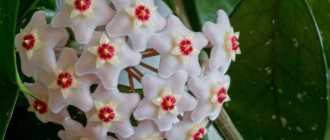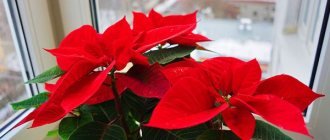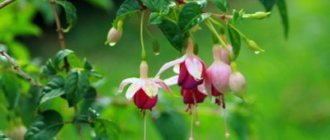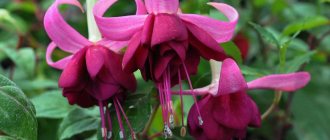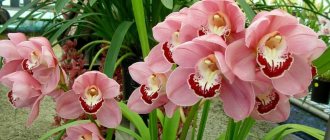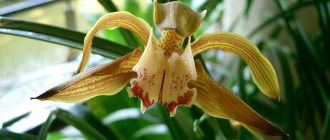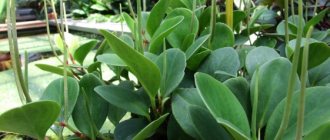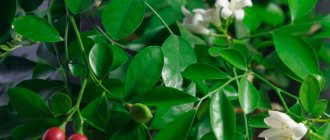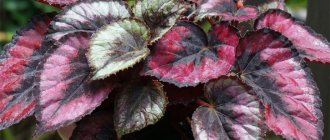All lovers of home flowers know Fittonia. This is an ornamental plant that decorates a house, apartment, office and other public spaces. The plant belongs to the herbaceous type. Its homeland is South America.
Despite the fact that the plant came from warm countries, caring for Fittonia at home is simple, and its adaptation to the Russian climate is simply stunning. Even a novice amateur gardener can cope with self-cultivation.
General information about fittonia
| Family | acanthaceae |
| Origin | South America |
| Lifespan | perennial |
| Bloom | yes, except for hybrids |
| Shade tolerance | light-loving plant |
| Virulence | No |
| Price | 100-250 rub. |
Initially, Fittonia was grown exclusively in winter gardens or greenhouses, as it died under room conditions. But the work of breeders made it possible to adapt the finicky plant for home maintenance.
The size of the flower and environmental requirements allow it to be used in florariums. For this:
- select a glass container with a lid;
- add drainage and substrate;
- Water thoroughly;
- plant Fittonia;
- complement the composition with pebbles or decorative figures;
- close the florarium;
- after condensation appears, remove the lid for 1.5-2 hours.
After 10 days, the microclimate inside will normalize.
When growing Fittonia in a florarium, make sure that it does not rest against the walls and replant it every six months.
But the closest place to natural conditions for growing Fittonia is the paludarium. This is a special aquarium that imitates a swamp. Here the plant can be kept in a terrestrial, semi-submerged or underwater state. The main thing in this method is to choose the right container and equipment that can maintain the required level of light and humidity. The composition should be supplemented with fountains, decorative figures, as well as plants with similar environmental requirements - aglaonemas or alocasia.
Why do you dream?
The dream of Fittonia symbolizes a stable and prosperous course of affairs. A person who sees such a dream will no longer be bothered by quarrels, conflicts with loved ones and colleagues, and will no longer worry about the future.
- If a woman dreams of a flowering plant, she should be prepared for a fateful meeting with a worthy and reliable man.
- However, a fading fittonia in a dream warns that the dreamer and his family members are in danger. You need to be careful and not get involved in dubious matters.
- A dead flower dreams of tears and sadness. This will probably be caused by news of a serious illness or death of a loved one.
Description and flowering
The leaves of the flower are ovoid with a pointed tip, located on thin short shoots, making the plant look like a carpet. The color varies from light green to dark emerald. A distinctive feature of the leaves is a mesh pattern formed by white, red or pink veins. An adult flower reaches a height of 10 to 40 cm.
At home, the culture rarely blooms. The buds are small and dim. Most often grayish-yellow or yellow-brown. It is recommended to trim them, since their formation takes a lot of energy from the plant.
Home care
For greater bushiness, the Fittonia is pinched and approximately a quarter of the plant’s length is removed. This pruning will help the flower become more luxuriant, and the torn parts will be useful for growing new ones; they take root well.
Spikelets take a lot of strength and energy from the plant. This cleaning will help new leaves appear and Fittonia will become even more magnificent. If you decide to leave flowers, then special care for the plant will not be required, while drafts are harmful, as is low temperature.
In winter, watering should be reduced, but sprayed systematically. It is necessary to control the condition of the flower’s soil; too dry will lead to the shedding of leaves, and wet soil will rot. Important! During the dormant period, starting from the second half of November, the ambient temperature drops to 20 0C, watering is reduced, and resumes from the end of February.
After purchasing Fittonia, the plant needs to be allowed to get accustomed to the new climate. You should not replant immediately; it is better to do it in a month. Be sure to provide good drainage.
Microclimate
| Characteristic | Optimal value |
| Temperature | 20-25˚С, no drafts or temperature changes. |
| Humidity | Increased throughout the year. |
| Lighting | Photophilous, does not tolerate direct sunlight. In winter it is necessary to supplement the lighting with phytolamps. |
You can maintain the required level of humidity by using a tray with wet expanded clay or moss, as well as regular spraying.
Choosing a place for a flower
Windows on the western or eastern side will provide the fitton with the necessary diffused light. But it is better to choose a well-lit place in the back of the room. Please note that the flower cannot be left near radiators and open windows.
Where is the best place to put it?
- A pot of fittonia placed in the bedroom will give you a calm and serene sleep and relieve nightmares and anxiety.
- If you place a flower near your workplace or in your office, it will relieve the feeling of fatigue and tension, improve memory, attentiveness, and help you better perceive information.
- A plant in the living room will provide a warm and trusting atmosphere and teach household members to listen to each other.
Fittonia in the house is a talisman against external negative influences and the keeper of a cozy atmosphere, strong and trusting relationships between family members. The flower awakens in the owner a sense of self-confidence and the ability to control his life, directing it in the direction he needs.
Priming
- Characteristics: nutritious, loose, able to retain moisture.
- Composition: humus, peat, leaf soil and sand in a ratio of 1:1:3:1.
- Drainage: expanded clay, pebbles, broken brick.
You can prepare the substrate yourself, but with this method there is a possibility that the soil will not be suitable due to the content of any impurities. In the store, choose a specialized substrate for fittonia.
Expert opinion
Mokhov Andrey Petrovich
Graduated from KubSAU, specialty: agronomy
Before planting, disinfect the soil: freeze or heat it. Additionally, saturate it with a solution of potassium permanganate.
Reproduction
Fittonia is propagated by apical cuttings. They can be collected during pruning, the main thing is that the shoot has at least three leaves up to 7 cm long. A moist substrate or settled water is suitable for rooting cuttings. At the same time, its level in the container should not be higher than 1 cm. The shoots must be kept in greenhouse conditions at a temperature not lower than 25˚C.
To do this, it is recommended to use cellophane or a glass container. It is important to carry out regular ventilation and spraying. After about a month, the “cap” needs to be removed, and later, when the plant gets stronger, transplanted to a permanent place.
Expert opinion
Mokhov Andrey Petrovich
Graduated from KubSAU, specialty: agronomy
Fittonia is also propagated by dividing the bush during transplantation.
The flower is easily propagated by layering. To do this, the shoot must be covered with earth. After some time, roots will appear. After they are strengthened, the plant can be separated from the parent and replanted.
Seating
Fittonia is propagated in several ways:
- Dividing the bush. During the annual replanting, you need to divide the bush into parts, being careful not to damage the root system, and plant it in separate pots.
- Cuttings. Cut tops of shoots (cuttings), having 3-5 leaves, take root well in damp sand or water. A cutting, the length of which does not exceed 8 cm, takes root without problems. You will need to create a greenhouse by covering the container with glass or film. The temperature should be from +25 to +28° C. Rooting occurs within 30 days.
- By layering. After a short time, roots appear on parts of the Fittonia stem (if they are sprinkled with moist soil), which must subsequently be separated and planted in another flowerpot. In some cases, when the container is wide, creeping stems take root on their own.
Advice: Plant several cuttings in one flowerpot; this will ensure the bush’s lushness and visual appeal in the future.
Fertilizer and feeding
Fittonia needs fertilizer from April to September.
- Complex mineral fertilizers - “Etisso”, “Hesi Phosphorus Plus”, “Agree’s”, “Multiflor Aqua”, etc. Apply once every 2 weeks, at a concentration of 50% of that indicated on the package.
- Organic fertilizers - manure, humus, bird droppings, peat, ash, onion or potato broth, sugar, aquarium water, etc. It is recommended to use once every 3 weeks.
- Foliar feeding: once a month. Organic - onion peel decoction, ash, beer or lemon solution.
- Mineral - “Zelenit”, “JOY”, etc.
Do not foliar and root fertilize at the same time. There must be at least 10 days between them. Do not spray the leaves for a couple of weeks after replanting or illness.
Transfer
The bush grows quite quickly, so at a young age it needs to be replanted annually. As Fittonia grows, transplants are carried out less frequently - 1 procedure every 3 years will be enough. Fittonia mix in a pot should feel spacious. Transplantation is carried out by transshipment without clearing the root system of soil.
Planting Fittonia mix in wide containers
Watering
- In spring and summer: abundantly and often - as the top layer of soil dries out.
- In autumn-winter: gradually reduce the frequency, by the beginning of winter switch to the watering mode, when the plant is given water 1-2 days after the top layer of the substrate has dried.
The soil should not be allowed to dry out, but it is also not recommended to flood it. Fittonia is prone to a high degree of moisture evaporation through the leaves, so the soil in the pot dries out quite quickly. For irrigation, it is better to use melt, rain or distilled water. If this is not possible, then you will have to water with treated water supply:
- you need to add a few drops of lemon juice or citric acid powder;
- wait until sediment appears in the form of light gray flakes;
- strain.
If you are going on vacation
- Prepare the plants for your departure: check for diseases and pests, stop feeding two weeks in advance, thin out the leaves and cut off the buds.
- Place the flowers in partial shade, next to each other, in trays with damp expanded clay, moss or pebbles.
- Water thoroughly, mist the leaves and place covers over the pots to retain moisture.
- Buy or make an automatic watering system.
Original solutions
The Fittonia plant is the optimal solution as a simple, but beautiful indoor plant. Suitable for both busy people who are not very keen on growing flowers, and avid florists.
The plant fits into both work and holiday environments. It will look great in a bedroom, living room or personal office. The color range is sufficient. From bright to grayish colors, depending on the species.
Diseases and pests. Table
Fittonia has no specific pests and practically does not get sick. But if the conditions of detention are violated, it may be susceptible to infection by omnivorous parasites.
| Diseases and pests | Causes | Symptoms | Methods of control and prevention |
| Rot of stems and roots | Frequent watering, especially in a cold room, leads to the appearance of fungus. | Wet soil, lifeless plant appearance, stems at the base soft and watery, leaves falling off. | Replanting into new soil. Treatment with Topaz. Water the plant correctly. |
| Spider mite | High air temperature and insufficient humidity | Dots on leaves that eventually merge into spots. The leaves fall off and there is a thin cobweb on their backs and stems. | Maintain the required level of humidity. If the pest has appeared recently, rinse the plant under a warm shower. Shake the water off the leaves and let dry. Spray with a solution of “Aktellika”, “Marshal”, “Omayta”, “Actofit” or “Apollo”. For greater effectiveness, carry out the procedure in the morning at a temperature above 20˚C. |
| Mealybug | White cotton wool-like sticky discharge. | Remove insects with a soft cloth and give the plant a warm shower. For a month, spray it with an alcohol-soap solution mixed with water, olive oil and citrus peels. In case of severe infection, use “Phosfamide”, “Aktara”, “Nurell-D”, “Rogor” or “Calypso”. The interval between procedures is 12–15 days. | |
| Thrips | Black or gray insects, larvae on the back of the leaf. Colorless spots, holes and silvery coating on the leaves. | Replant the flower, disinfect the pot. Use sticky traps. Spray with Actellik, Agravertin or Karbofos solution and leave for a day under a plastic bag. Carry out the procedure every 10 days until the parasites disappear. | |
| Shchitovka | Brownish plaques—insect shells—appear on the underside of the leaf blade. The leaves turn yellow and fall off. | Isolate the flower, wipe it with a cloth soaked in soapy water, leave for 40 minutes, and rinse the plant in the shower. Use “Aktellik”, “Fitoverm”, “Metafos” or “Aktara”. 2-3 treatments every 10 days. |
Problems with leaves
- They turn yellow, darken, dry out: insufficient humidity - spray more often.
- Droop, curl, shoots wither: insufficient watering - normalize the frequency and abundance.
- The tips turn pale and dry out: excess or lack of fertilizer; if you are not sure of the reason, replant.
- They become small and sparse, the shoots stretch out: lack of light - rearrange the flower or illuminate it with lamps.
- Light spots, the pattern fades: sunburn - move to a place with diffused light.
- Leaf falling: if the plant is older than 2 years and the lower leaves fall off, this is a natural process, in other cases it is a matter of lack of nutrients.
Why does it bloom?
Flowering of Fittonia is a favorable phenomenon. The appearance of flowers on a plant promises prosperity and peace in the house .
- For people pursuing a career, blooming Fittonia promises opportunities for concluding lucrative deals and promotions.
- Men and women free from relationships are foreshadowed by a meeting with their soulmate.
- For creative individuals, this is a sign that their talent will be recognized and they will achieve success and fame.
- If a plant blooms in the house of a sick person, this means a speedy recovery.
Types of Fittonia with photos and names
Mix (F. Gemengd)
This is not a separate species, but simply a variety of Fittonia planted in one pot. Typically, plants with leaves of different shades of green with bright veins are used for this.
Fittonia verschaffeltii or albivenis
It is a low-growing plant (up to 10 cm), which is highly branched. Its shoots are covered with soft fluff. The leaves are large, green with a crimson-pink pattern. Most breeding species have been bred on the basis of this variety.
- Silver veined Fittonia (Argyroneura) differs from the parent species in its silvery shiny mesh and small leaves.
- Red : ground cover shrub with bright olive leaves with purple or bright pink veins.
- Josan : This variety has light green leaves with a pink pattern. The edge of the leaves is bordered by a dark green stripe, which appears black from a distance.
- White Anne : stands out with a snow-white mesh and border, slightly darker than the main color.
- Skeleton : the red pattern almost matches the veins, the leaves are small, velvety and matte. The color intensity is so high that it can be mistaken for a glow. Shoots creep along the ground.
Giant or large fittonia (F. Gigantea)
Grows up to 60 cm, has oblong glossy dark green leaves. Their surface is dotted with red veins. The shoots are purple-red and become woody over time. The variety is least adapted to home conditions.
Dwarf (F. microphylla)
The plant has small (up to 2.5 cm) emerald green leaves with a white or silver pattern.
